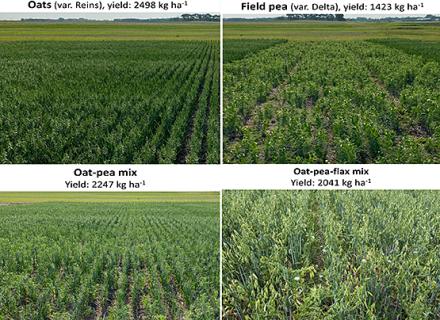Oats and Peas: A Winning Combination?

Research plots allowed scientists to compare different intercropping mixtures. (Photo courtesy of ARS).
Intercropping is the practice of growing multiple crops together on the same land at the same time. It’s an ancient technique that is gaining renewed interest in today’s agriculture. Oats and field peas are commonly found together in livestock feed and planting them together in an intercropping system can offer significant advantages for farmers, too. Peas in particular, as legumes, are an ideal intercropping plant because they enhance soil health by fixing nitrogen from the atmosphere, reducing the need for synthetic fertilizers.
“Oats and peas can be planted close together on the same farm, particularly in regions like the western Corn Belt,” said Dhurba Neupane, research agronomist at the ARS Integrated Cropping Systems Research Unit in Brookings, SD. “Oats and peas have complementary benefits and have similar planting and harvest dates. Oats can take advantage of the nitrogen-fixing ability of peas, while peas benefit from the structural support from the oats, making them a good synergistic pair for intercropping.”
U.S. growers are facing ever increasing challenges these days, with growing production costs, the demand for more yields, environmental concerns, and unpredictable conditions. Ensuring sustainable food production while conserving biodiversity and ecosystem services is a challenge, and there is a need for highly productive, and land-use-efficient cropping systems.
“This research is important because it addresses the dual challenge of feeding a growing population while conserving the environment,” said Neupane. “Intercropping can improve system productivity, enhance soil health, and provide ecosystem services, making it a vital area of research for sustainable agriculture.”
Researchers at the Integrated Cropping Systems Research Unit are studying whether intercropping can improve sustainable food production by providing higher and more stable yields, improved land use efficiency, and enhanced nutritional value compared to growing a single crop. They also noted that intercropping may provide ecosystem services such as weed suppression and a home for predatory arthropods that fight off pesky insects. This is especially important in the U.S. Corn Belt.
“The Corn Belt is largely dependent on monoculture systems, which can lead to soil degradation and increased pest pressures,” Neupane said. “Diversified cropping systems, such as crop rotation and intercropping, can improve soil health, enhance ecosystem services, and create a more resilient agricultural system in this region.”
The primary question for growers interested in intercropping is, “which crops to comingle?” ARS researchers noted that choosing plants to intercrop should be based on their complementarity in use of light, water, and nutrients, due to their different functional traits such as rooting abilities, canopy structures, and nutrient requirements. In order to determine the viability and benefits of intercropping cereal and legume crops in the Western Corn Belt, researchers planted a combination of oats, field pea, and flax mixtures. These plants were chosen for their potential agronomic, adaptation, and ecosystem services benefits across contrasting weather patterns. The fields were managed as no-till with synthetic fertilizer and herbicide application, and two planting dates were chosen, in late April and early June, in order to provide different growing conditions. Plant biomass, weed biomass, grain yield, arthropods, and grain feed quality were measured for each planting.
Researchers determined that yields varied for the individual plantings, depending on the planting dates, but were consistent for the oat-pea intercrop. Analysis of livestock feed quality, a secondary revenue source for growers, revealed that compared to oat alone, the oat-pea mixture provided well-balanced forage for lactating dairy cattle and high-performing beef cattle. The amount of weeds present was also low across both weather contexts, which suggests that oat-pea polycultures were consistently able to outcompete weeds for light, water, and nutrient resources. Finally, intercropping provided a welcome habitat for beneficial arthropods that can provide biocontrol against crop-damaging insects.
Researchers plan on conducting multi-location field trials to assess the impact of intercropping oat, pea, canola, and berseem clover on agricultural productivity, stability, feed quality, and ecosystem services such as weed suppression and habitat for arthropods.
“We hope to provide insights that encourage the adoption of intercropping systems, leading to more sustainable agricultural practices and improved food security,” Neupane said. “By promoting intercropping, our research supports the development of more resilient farming systems that can improve productivity, reduce chemical inputs, and enhance ecosystem services, eventually benefiting both agriculture and the environment.” – By Todd Silver, ARS’s Office of Communications.

